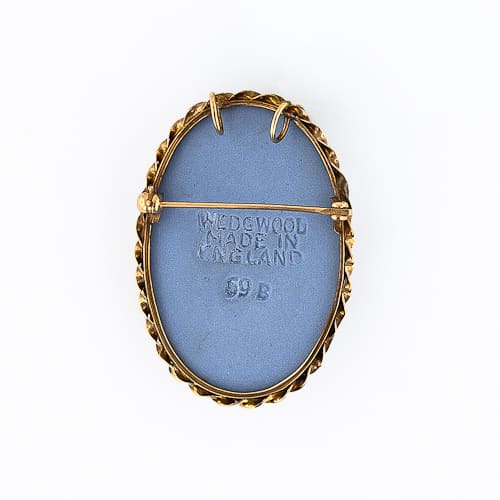Wedgwood jasperware dating
Contents:
An illustrated list of Wedgwood Marks presented in chronological order
Jasper starts out white, and then color is added. Older pieces were "solid" - the color permeated the stoneware - while most pieces today are "dipped," colored only on the surface.

Of course, the earlier specimens are the most valuable, and for the purposes of dating, the collector is fortunate that Wedgwood has been fairly consistent throughout its history in marking its products. Reference can be made to several books and websites see below that chart the changes in marks over time, and are most useful in determining the period in which a particular piece was likely to have been made.
How to Date Wedgwood | Our Pastimes
These were all marks used by various manufacturers that had no connection to the company founded by Josiah Wedgwood. Wedgwood" was actually John Wedge Wood, who worked between and Keefe III Link to book. Check out the Wedgwood pages describing the different types of wares, marks, etc.
The more modern versions can be quickly identified if you know what to look for. This example has a few clues to its vintage: In the current market, the values for most modern Jasperware—particularly the smaller pieces—are very modest. But the larger pieces, like these urns, still bring good prices at auction.
Navigation menu
By continuing to use the site, you are consenting to the use of cookies as explained in our Privacy Policy to improve your experience. Sign In Start Free Trial. Teawares are usually glazed on the inside. In the original formulation the mixture of clay and other ingredients is tinted throughout by adding dye often described as "stained" ; later the formed but unfired body was merely covered with a dyed slip , so that only the body near the surface had the colour.
How to Date Austrian Pottery. A rare mark found on plaques and ornamental wares. Commons category link from Wikidata Wikipedia articles incorporating a citation from the Encyclopedia Americana with a Wikisource reference. Printed in various colours. The first impressed mark on earthenware. Email her at makalice adelphia.
These types are known as "solid" and "dipped" or "Jasper dip" respectively. The undyed body was white when fired, sometimes with a yellowish tinge; cobalt was added to elements that were to stay white. Named after the mineral jasper for marketing reasons, the exact Wedgwood formula remains confidential, but analyses indicate that barium sulphate is a key ingredient. He had been researching a white stoneware for some time, creating a body called "waxen white jasper" by This tended to fail in firing, and was not as attractive as the final jasperware, and little was sold.
Jasperware's composition varies but according to one 19th-century analysis it was approximately: Barium sulphate "cawk" or "heavy-spar" was a fluxing agent and obtainable as a by-product of lead mining in nearby Derbyshire.
Jasperware
The fired body is naturally white but usually stained with metallic oxide colors; its most common shade is pale blue, but dark blue, lilac, sage green described as "sea-green" by Wedgwood , [10] black, and yellow are also used, with sage green due to chromium oxide , blue to cobalt oxide , and lilac to manganese oxide , with yellow probably coming from a salt of antimony, and black from iron oxide.
The yellow is rare.
NOTE: If the ware has '& CO' in the mark or stamp then it does not belong to Josiah Wedgwood but to Wedgwood & Co (Ltd). NOTE: If the ware has a middle ' E'. A few years ago, when I couldn't find detailed information regarding the colors and date periods Jasperware has been produced in, I compiled.
A few pieces, mostly the larger ones like vases, use several colours together, [13] and some pieces mix jasperware and other types together. The earliest jasper was stained throughout, which is known as "solid," but before long most items were coloured only on the surface; these are known as "dipped" or "dip". Dipping was first used in , Wedgwood writing that "the Cobalt 36s.
- what age to try online dating?
- dating advice for women in their 20s?
- It’s All in the Marks: Dating a Wedgwood Jasperware Urn?
Solid jasper was not manufactured again until In the best early pieces the relief work was gone over, including some undercutting, by lapidaries. The artists used for jasperware cannot always be identified, as they are not named on pieces they designed. William Hackwood was his chief in-house modeller, who was sometimes allowed to initial pieces.
Jasperware is particularly associated with the neoclassical sculptor and designer John Flaxman Jr who began to supply Wedgwood with designs from Flaxman mostly worked in wax when designing for Wedgwood. Sir William Hamilton 's collection of ancient Greek vases was an important influence on Flaxman's work.
- dating jade artifacts?
- Wedgwood Marks?
- over 30s speed dating birmingham?
- how radiocarbon dating is done?
- How to Date Wedgwood?
- age limits for dating in canada?
- best dating site in auckland?
These vases were first known in England from D'Hancarville 's engravings, published from